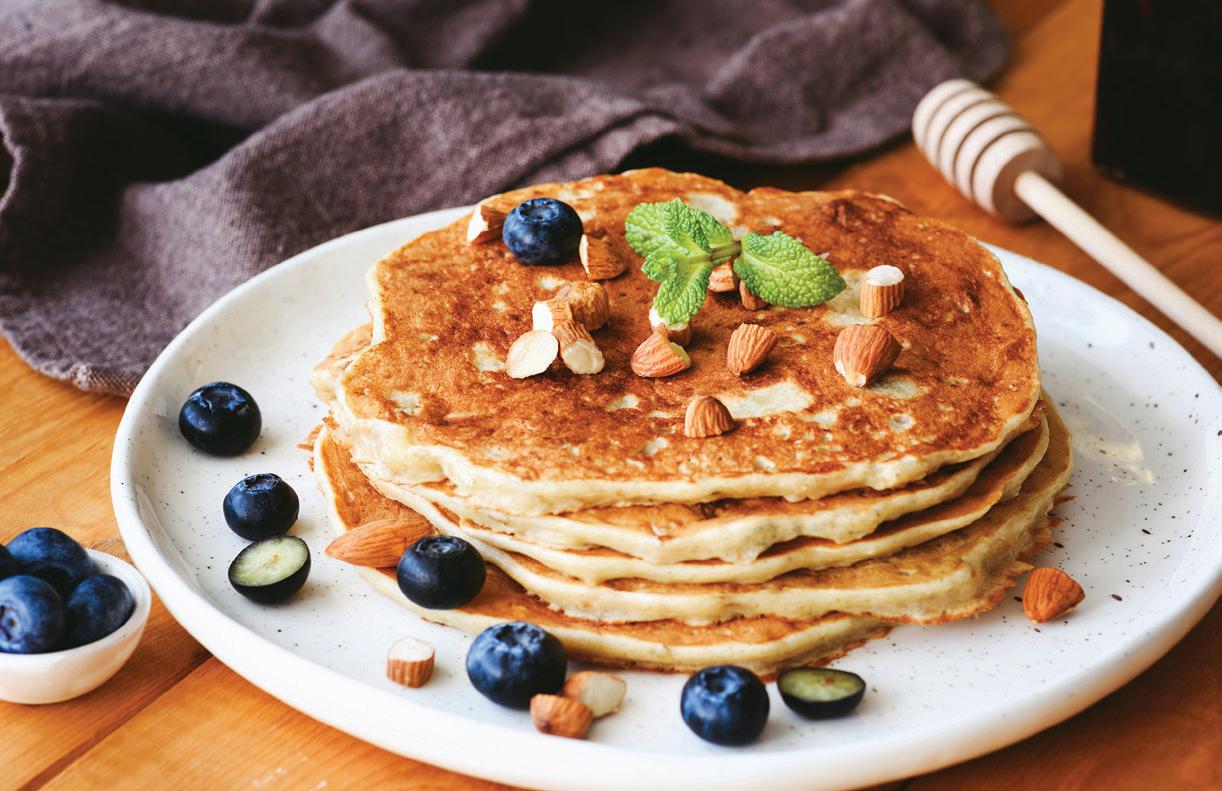
16 minute read
Livin’ la Vida Low-Carb
Good Health TM LIFESTYLES
LOW-CARB Livin’ La Vida
Advertisement
Bring a little creativity to the kitchen with these low-carb alternatives for your favorite foods

Does it ever feel like the whole world has gone low-carb? From those oodles of “zoodles” to the lettuce-wrapped burgers at your local fast food joint, carbohydrates are definitely out and diets like keto and paleo are in. Want to bring the low-carb life to your kitchen? Check out our tasty substitutes for the carbs you crave.
ALMOND-BLUEBERRY PANCAKES silver dollar
Silver Dollar AlmondBlueberry Pancakes
SERVES 4 For many people, Sunday morning just isn’t complete without a hearty stack of pancakes. Satisfy your sweet tooth with these gluten-free, low-carb flapjacks topped with a dollop of almond butter.
2 cups almond flour 4 eggs ¼ cup coconut oil, melted ½ cup unsweetened almond milk 1 teaspoon baking soda Erythritol or stevia, to taste ½ cup small blueberries ¼ cup ghee
1 Mix all the ingredients, except blueberries, in a large bowl until smooth. Stir in blueberries. Set aside.
2 Heat a large skillet over medium heat. Add 1 tablespoon of the ghee and swirl the pan to melt. Pour about ⅛ cup of the batter into the pan for each pancake. Flip when the edges are set. Cook an additional 1-2 minutes or until the second side is golden. Repeat with the remaining batter, using the remaining ghee as needed.
Per serving: Calories 559; Total Fat 47g; Carbs 15g; Protein 19g; Sodium 94mg; Sugar 4g

KETO BREAD in a mug Keto Bread in a Mug
SERVES 2 This 90-second alternative is a great grainfree swap when you’re longing for bread.
1 tablespoon butter ⅓ cup blanched almond flour 1 large egg ½ teaspoon baking powder Pinch sea salt
1 Place butter in a microwave-safe mug. Microwave until melted, about 20-30 seconds. Swirl butter in the mug until the mug is fully coated. 2 Add the remaining ingredients to the mug and whisk until smooth. 3 Microwave on high for 90 seconds, or until set. Cool for 5 minutes, then remove from mug and slice.
Per serving: Calories 184; Total Fat 17g; Carbs 4g; Protein 7g; Sodium 159mg; Sugar 1g
SERVES 4 Using cauliflower as a stand-in for rice is so 2019! Take it up a notch with these two variations ofcauliflower rice to perk up any meal. Not only is cauliflower low-calorie and low-carb, it’s also bursting with immune-supporting vitamin C. Guilt-Free Margherita Pizza
SERVES 4 Ditch the delivery! Cauliflower, egg, and cheese combine to make a delicious crust that’s low-carb and keto-friendly. The best part? It’s ready in about the same amount oftime as take out!
Greek Cauli-Rice
½ cup sliced almonds 1 head cauliflower, riced or storebought cauliflower rice 2 tablespoons extra-virgin olive oil 1 clove garlic, minced ¼ teaspoon sea salt ½ cup flat-leafed parsley, chopped 1 tablespoon lemon juice Freshly ground pepper, to taste
1 Toast the almonds in a large skillet over medium heat, stirring frequently until golden. Transfer to a bowl and set aside. 2 In the same skillet, heat the oil. Add the cauliflower rice, garlic, and salt, stirring to combine. Cook, stirring occasionally for 6-8 minutes or until the cauliflower is golden and tender.
3 Remove the skillet from the heat and stir in the almonds, parsley, lemon juice, and pepper. 4 Adjust seasonings to taste. Serve warm.
Per serving: Calories 193; Total Fat 15g; Carbs 11.6g; Protein 6.7g; Sodium 188mg; Sugar 3.5g
Cilantro Lime Rice
1 head cauliflower, riced or store-bought cauliflower rice 1 tablespoon extra-virgin olive oil ⅓ cup cilantro, chopped 2 tablespoons lime juice 1 teaspoon garlic powder ½ teaspoon onion powder ½ teaspoon sea salt ¼ teaspoon ground pepper
1 In a large skillet over medium heat, heat the oil. Add the cauliflower rice and cook for 3 minutes, stirring frequently. Cover and cook for an additional 5 minutes or until tender. 2 Remove the skillet from the heat and stir in the cilantro, lime juice, garlic powder, onion powder, salt, and pepper.
3 Serve warm.
Per serving: Calories 68; Total Fat 4g; Carbs 7g; Protein 3g; Sodium 287mg; Sugar 3g


1 head cauliflower, roughly chopped 1 large egg 2 cups shredded mozzarella cheese, divided ½ cup grated Parmesan cheese, divided ¼ teaspoon garlic powder ¼ cup marinara sauce 1 small Roma tomato, thinly sliced 2 cloves garlic, minced Fresh basil, cut into ribbons
1 Preheat oven to 425°F. Spray a baking sheet with cooking oil and set aside. 2 Pour ¼-inch of water into a large skillet and bring to a boil. Add cauliflower in an even layer and cook until crisp-tender, about 3-4 minutes. Transfer cauliflower to a clean dish towel and squeeze out remaining water.
3 Put the cauliflower into the bowl of a food processer and pulse until grated. Drain out any water and transfer the cauliflower to a large bowl. 4 Add the egg, 1 cup mozzarella, and ¼ cup Parmesan to the bowl. Season with salt to taste. Stir to combine well.
5 Transfer the mixture to the baking sheet and pat into a ¼-inch thick circle. Bake until golden and dry, about 20 minutes. Remove the crust from the oven and cool slightly. 6 Top the crust with marinara, remaining cheese, tomato, and garlic. Bake for an additional 10 minutes or until cheese has melted.
7Garnish with basil and serve warm.
WEIGHT TRAINING at EVERY AGE
Here’s why grabbing a pair of dumbbells may be the smartest thing you can do!

by Carol Ann Weber

Jack LaLanne once noted that “It’s better to wear out than rust out.” Yet, in today’s sedentary society, many Americans are rusting! One of the best ways to stop rusting and get back into the game called life is with resistance training. Lifting weights—or using your own body weight to create resistance—increases strength, improves balance, and helps maintain good health. It’s so effective that scientific studies have validated numerous health benefits of weightlifting—for both men and women. Here’s why resistance training matters: From birth to around age 30, your muscles are programmed to grow stronger and larger. But somewhere in your 30s, research indicates that muscle mass and function begin to decline at a rate of three to five percent per decade. This is called sarcopenia. But if you are physically BodyWeight Exercises 30 active and engage consistently in resistance/weight training, you can maintain most of your muscle mass well into your 70s and 80s. How to get started? Our simple guide will point you on the way, whether you’ve never lifted a dumbbell or you used to be a regular in the weight room.
FUNCTIONAL FITNESS Mobility, range of motion, strength, and stamina are of primary importance to meet the demands of daily life, especially as you age. The more functional you are, the better able you are to handle the tasks of daily living. Here are some of the best resistance exercises—using both your body weight and free weights—to include in your workouts.
Bodyweight exercises can be done anywhere, anytime—no equipment needed!
Plank: To do this corestrengthening exercise, lie face down on a mat with your
forearms on the floor in front of you. Extend your legs behind your body and rise
TIPS for a Better Workout
• Aim to lift weights 2-3x per week.
• Track your FORM and control the full range of motion for each exercise. • Include at least one exercise that works your CORE (abdominal muscles) during each weighttraining session.
• Start with a LOW WEIGHT and adjust the weight upward as you become stronger.
• Add a 30-MINUTE AEROBIC session on two or three of your off days.
up on your toes. Keeping the back straight, tighten your core and hold the position for 30 to 60 seconds (or as long as you can). Repeat 3 times.
TRAUMAPLANT The Cream EVERYONE NeedS!
PAs
PA-Free
Safe for Ages 4+

Start Seeing Results in 15 Minutes 17 Clinical Studies
• Millions sold worldwide, now available in the U.S. and Canada • Non-staining comfrey cream • A must have for every home, backpack, gym bag, kitchen and purse!
Superman: Lie face down with your arms and legs extended. Keeping the torso as stable as possible, simultaneously raise the arms and legs to form a small curve in the body. Hold for as long as possible, then repeat 3 to 5 times. Cape optional.

Overhead Squats: Stand with your feet shoulder-width apart with your toes facing forward. Reach your arms overhead with your palms facing each other. Lower into a squat. Be sure to keep your core engaged and your chest up to avoid leaning too far forward. Do 3 sets of 10 repetitions each.

FreeWeight Exercises
Kettlebell Swing: To work your hips, glutes, hamstrings, back, abs, shoulders, chest, and grip, stand with legs slightly wider than shoulderwidth and grasp the kettlebell with both hands. Raise the kettlebell straight out in front of you until it is shoulder height. Swing the kettlebell down between your legs as you bend
32 your knees. Keep your back straight, and your glutes
and abs fully engaged. Smoothly swing the
kettlebell back up until it is no higher than your shoulders as you return to a standing position. Complete 3 sets of 10 repetitions each.
Kettlebell Squats: Stand straight with feet shoulder-width apart. Hold a kettlebell in both hands in the center of the chest. Lower into a squat to a count of 4, keeping your core engaged and your chest up. Straighten your legs as you raise your body to the starting position. Work up to 3 sets of 10 to 20 repetitions each.
Seated Dumbbell Bicep Curls: Seated on a chair or bench with your back straight, start by holding a dumbbell in each hand with your palms facing inward and your arms extended toward the floor. Keeping your elbows at your sides, turn your palms up as you slowly bring the dumbbells towards your shoulders. Hold for a few seconds then slowly lower your arms back to the starting position. Do 3 sets of 10 repetitions.
Additional Benefits of Weightlifting 5
WEIGHT LOSS. As you build muscle, your body composition changes. Fat doesn’t turn to muscle. When muscle size increases so does your metabolism and you will burn more calories just by moving your body.
COGNITIVE FUNCTION. Exercise is as much a way to stay mentally sharp as it is a way to stay physically fit.
BONE DENSITY. You can protect the amount and density of the minerals in your bones with weight-bearing exercise.
BALANCE. Weight training increases muscle strength and keeps the skeleton in alignment. Plus, the slow rhythmic movements used in weightlifting stimulates the development of new motor patterns in the brain that foster better balance.
CARDIOVASCULAR HEALTH. Resistance exercise has been shown to improve left ventricular function in the heart, as well as heart muscle strength and endurance. It also improves blood flow throughout the body.
Triceps Dumbbell Kick-backs: Bending over a flat bench, place your left knee on the bench with left hand gripping the front of the bench to support your upper body. With a dumbbell in your right hand and your upper arm against your side, bring the dumbbell back as you straighten your arm. Repeat for 12 repetitions and then switch sides. Complete 3 sets per side.
Carol Ann Weber’s 500+ articles have been published in magazines such as Fitness Rx, Muscle & Fitness, Oxygen, and Men’s Fitness. She has also been named the Academy of Bodybuilding and Fitness “Best Columnist of the Year.” Along with weight training, she enjoys yoga and a brisk walk anywhere outdoors.












SUCONTRAL ®
D
• Healthy A1C Levels † • Healthy Insulin Function and Glucose Support † • Carbohydrate Metabolism * SUPPORT FOR:











Years of Research Proves It 60 Years of Research Proves It
Scientists have discovered a unique compound in a time-tested herb, Hintonia latifl ora, to be a safe, effective way to powerfully support healthy blood sugar balance—validated by over 60 years of German research. * †
ALTERNATIVE MEDICINE CHEST



HEARTBURN AND GERD
Most people will experience heartburn at some point in their life. For an estimated 15 to 30 percent of Americans, frequent bouts of heartburn can actually be a sign of gastroesophageal reflux disease (GERD), a more serious condition that occurs when stomach acid repeatedly washes up into the delicate structures of the esophagus and causes damage. Although TV commercials steer many people toward a plopplop-fizz-fizz or “purple pill” solution, they are not the answer. With the capability to alter stomach acidity, mineral status, and body pH—and potentially compromise the immune system—consistent antacid use can alter the bacterial balance in the intestinal tract and cause harm. Before you reach for that OTC solution, check out these five safe and effective alternatives that can ease the discomfort and soothe an inflamed esophagus and injured stomach lining.
D-limonene:

D-limonene is a clinically tested component of the citrus oil in oranges, grapefruits, lemons, and limes. Citrus fruits have a reputation for causing heartburn, but d-limonene has been shown to stop it. While researchers haven’t pinpointed its exact mechanism of action, d-limonene has been shown to effectively reduce or eliminate GERD symptoms. In one study, 19 adults with mild to moderate symptoms that had intermittently lasted for at least five years were instructed to discontinue their overthe-counter or prescription medications and take d-limonene instead. The first day, they reported a 5 or higher pain level, with 1 being pain-free and 10 equaling severe pain. By day two, 32 percent of the participants experienced symptom relief bringing their level to 1 or 2. After 14 days, 89 percent of the participants were symptom-free. Similar results were found in another double-blind, placebocontrolled study, with 86 percent of participants reporting complete relief within two weeks.

In addition to its ability to relieve the symptoms of acid reflux, d-limonene also supports peristalsis (involuntary muscle contractions in the intestines that move food through the digestive system) without shutting down the production of stomach acid. Taken together, these actions make this natural citrus supplement an excellent tool for those with GERD, especially when it’s combined with sea buckthorn.


When heartburn strikes, your first priority is to calm the fire fast! Deglycyrrhizinated licorice, or DGL, is a licorice extract with strong antioxidant and anti-inflammatory properties that has been clinically shown to increase the production of mucus. This, in turn, can ease discomfort and protect the stomach and esophagus from future instances of acid reflux. It works so well that a recent clinical trial found that taking DGL proved more effective than commonly used antacids.
In another study, DGL was found to provide overall relief from indigestion. During this randomized, double-blind, placebocontrolled study, 50 people with dyspepsia received either an encapsulated form of DGL twice daily or a placebo. After 15 days


Sea buckthorn: One of the key features of GERD is inflammation. Boswellia is a powerful anti-inflammatory herb derived from the bark of the Boswellia serrata tree. This aromatic resin has been used for thousands of years to treat numerous inflammatory digestive issues, especially when they involve the mucosal lining of the gut. Modern scientists have uncovered specific active boswellic acids known as acetyl-11-keto-β-boswellic acids (AKBA) that are responsible for the herb’s healing properties. The best form of boswellia is uniquely standardized to contain at least 10 percent AKBA. But check the label to ensure it doesn’t contain proinflammatory beta boswellic acids (BBA). On its own, or combined with an anti-inflammatory
diet, boswellia may help minimize the inflammation
involved in chronic acid reflux. Boswellia: and again at 30 days, participants taking the DGL capsules showed significant improvement in their symptoms, including heartburn, regurgitation, nausea, bloating, and the feeling of fullness. DGL is also a powerful antimicrobial shown to inhibit Helicobacter pylori, the bacteria that eats away at the lining of the stomach and causes ulcers. Most DGL supplements come in the form of strongly flavored chewables that can be off-putting to many people. For a more convenient option, look for DGL capsules standardized to contain 3.5 percent glabridin, the active compound in licorice. Each dose should also provide more than 10 percent total flavonoids.
If GERD symptoms tend to strike at night, try some melatonin. Studies suggest that just 6 mg of this sleepy-time supplement may work nearly as well as a popular proton pump inhibitor but without the side effects. Melatonin:

Sea buckthorn supplies the body with rare omega-7 essential fatty acids. This berry is so rich in benefits, it’s been called a “nutrient bomb.” In addition to omega-7, sea buckthorn is a rich source of flavonoids, water- and fat-soluble vitamins, plant lipids, and omega-3, 6, and 9 fatty acids. Evidence in the World Journal of Gastroenterology reports that the omega-7s in sea buckthorn support the mucosal lining throughout the digestive tract. Because of this, sea buckthorn is an effective aid for preventing and healing gastric ulcers.



To experience these protective benefits, search out a sea buckthorn supplement that includes both seed and pulp oil. It’s also wise to look for a solventfree, supercritical CO 2 extraction technology so you can be assured of a clinically tested, highly viable sea buckthorn.
35








